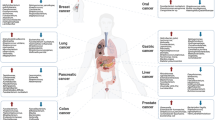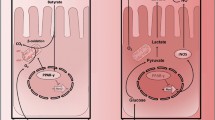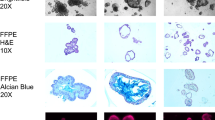Abstract
Objective
This study sought to evaluate short-term treatment with COX-2 inhibitors and acute changes in colonic PGE2 levels as predictors of long-term efficacy in a genetic model of colorectal cancer.
Methods
Celecoxib oral suspension (40 mg/kg BID) was dosed to Apc-mutant Pirc (F344/NTac-Apcam1137) rats for 4 days (short-term group), or the equivalent dose of 1500 ppm celecoxib was administered in the diet for 4 months (long-term group). Percent inhibition of colonic PGE2 was calculated, and the reduction in colonic PGE2 was assessed in relation to suppression of adenomatous colon polyps.
Results
Colonic mucosa PGE2 was fourfold higher in Pirc than in F344 wild-type rats (21 vs. 5.6 pg/mg epithelial tissue), due at least in part to higher COX-2 expression, and this was confirmed by elevated PGE2-d11 levels in Pirc colonic S9 incubations. In the 4-day study, dose-dependent reductions in PGE2 were observed in colonic epithelium (-33% (P>0.05) and -57% (P=0.0012)), after low- and high-dose celecoxib treatments of 4 mg/kg and 40 mg/kg (bid), respectively. In the 4-month study, 1500 ppm celecoxib suppressed colonic epithelium PGE2 by 43.5%, and tumor multiplicity by 80% (P<0.0015). Suppression of plasma 6-keto PGF1α also was corroborated following long-term treatment with 1500 ppm celecoxib (P<0.05).
Conclusions
Acute changes in colonic mucosa PGE2 provided a rapid means of predicting long-term chemopreventive effects from celecoxib, and might be useful for screening of new COX-2 inhibitor compounds.






Similar content being viewed by others
Abbreviations
- AA:
-
Arachidonic acid
- APC :
-
Adenomatous polyposis coli
- COX:
-
Cyclo-oxygenase
- Coxib:
-
COX-2 inhibitor
- CRC:
-
Colorectal cancer
- FAP:
-
Familial adenomatous polyposis
- FDA:
-
Food and Drug Administration
- Pirc rat:
-
Polyposis in the rat colon rat (F344/NTac-Apcam1137)
- IC50:
-
Half-maximal inhibitory concentration
- LC–MS:
-
Liquid chromatography–mass spectrometry
- NSAID:
-
Non-steroidal anti-inflammatory drug
- PGE2 :
-
Prostaglandin E2
- 6-keto PGF1α :
-
6-Keto prostaglandin F1α
References
Kinzler KW, Vogelstein B. Lessons from hereditary colorectal cancer. Cell. 1996;87:159–70.
Galiatsatos P, Foulkes WD. Familial adenomatous polyposis. Am J Gastroenterol. 2006;101:385–98.
Half E, Bercovich D, Rozen P. Familial adenomatous polyposis. Orphanet J Rare Dis. 2009;4:22.
Knudsen AL, Bisgaard ML, Bulow S. Attenuated familial adenomatous polyposis (AFAP). A review of the literature. Familial cancer 2003; 2:43-55.
Gupta RA, Dubois RN. Colorectal cancer prevention and treatment by inhibition of cyclooxygenase-2. Nat Rev Cancer. 2001;1:11–21.
Zelenay S, van der Veen AG, Bottcher JP, Snelgrove KJ, Rogers N, Acton SE, et al. Cyclooxygenase-dependent tumor growth through evasion of immunity. Cell. 2015;162:1257–70.
Greenhough A, Smartt HJ, Moore AE, Roberts HR, Williams AC, Paraskeva C, et al. The COX-2/PGE2 pathway: key roles in the hallmarks of cancer and adaptation to the tumour microenvironment. Carcinogenesis. 2009;30:377–86.
Sonoshita M, Takaku K, Sasaki N, Sugimoto Y, Ushikubi F, Narumiya S, et al. Acceleration of intestinal polyposis through prostaglandin receptor EP2 in Apc(Delta 716) knockout mice. Nat Med. 2001;7:1048–51.
Kwong LN, Dove WF. APC and its modifiers in colon cancer. Adv Exp Med Biol. 2009;656:85–106.
Corpet DE, Pierre F. How good are rodent models of carcinogenesis in predicting efficacy in humans? A systematic review and meta-analysis of colon chemoprevention in rats, mice and men. Eur J Cancer. 2005;41:1911–22.
Zeineldin M, Neufeld KL. More than two decades of Apc modeling in rodents. Biochem Biophys Acta. 2013;1836:80–9.
Moser AR, Pitot HC, Dove WF. A dominant mutation that predisposes to multiple intestinal neoplasia in the mouse. Science. 1990;247:322–4.
van Boxtel R, Gould MN, Cuppen E, Smits BM. ENU mutagenesis to generate genetically modified rat models. Methods Mol Biol. 2010;597:151–67.
Irving AA, Yoshimi K, Hart ML, Parker T, Clipson L, Ford MR, et al. The utility of Apc-mutant rats in modeling human colon cancer. Disease Models Mech. 2014;7:1215–25.
Rajendran P, Johnson G, Li L, Chen YS, Dashwood M, Nguyen N, et al. Acetylation of CCAR2 establishes a BET/BRD9 acetyl switch in response to combined deacetylase and bromodomain inhibition. Can Res. 2019;79:918–27.
Amos-Landgraf JM, Kwong LN, Kendziorski CM, Reichelderfer M, Torrealba J, Weichert J, et al. A target-selected Apc-mutant rat kindred enhances the modeling of familial human colon cancer. Proc Natl Acad Sci USA. 2007;104:4036–41.
Femia AP, Soares PV, Luceri C, Lodovici M, Giannini A, Caderni G. Sulindac, 3,3′-diindolylmethane and curcumin reduce carcinogenesis in the Pirc rat, an Apc-driven model of colon carcinogenesis. BMC Cancer. 2015;15:611.
Femia AP, Luceri C, Soares PV, Lodovici M, Caderni G. Multiple mucin depleted foci, high proliferation and low apoptotic response in the onset of colon carcinogenesis of the PIRC rat, mutated in Apc. Int J Cancer. 2015;136:E488–95.
Ertem F, Dashwood WM, Rajendran P, Raju G, Rashid A, Dashwood R. Development of a murine colonoscopic polypectomy model (with videos). Gastrointest Endosc. 2016;83:1272–6.
Yun C, Dashwood W-M, Kwong LN, Gao S, Yin T, Ling Q, et al. Accurate quantification of PGE2 in the polyposis in rat colon (Pirc) model by surrogate analyte-based UPLC–MS/MS. J Pharm Biomed Anal. 2018;148:42–50.
Yun C, Yin T, Shatzer K, Burrin DG, Cui L, Tu Y, et al. Determination of 7alpha-OH cholesterol by LC-MS/MS: application in assessing the activity of CYP7A1 in cholestatic minipigs. J Chromatogr B Anal Technol Biomed Life Sci. 2016;1025:76–82.
Mukherjee D, Nissen SE, Topol EJ. Risk of cardiovascular events associated with selective COX-2 inhibitors. JAMA. 2001;286:954–9.
Antman EM, DeMets D, Loscalzo J. Cyclooxygenase inhibition and cardiovascular risk. Circulation. 2005;112:759–70.
McAdam BF, Catella-Lawson F, Mardini IA, Kapoor S, Lawson JA, FitzGerald GA. Systemic biosynthesis of prostacyclin by cyclooxygenase (COX)-2: the human pharmacology of a selective inhibitor of COX-2. Proc Natl Acad Sci USA. 1999;96:272–7.
Cannon CP, Cannon PJ. Physiology. COX-2 inhibitors and cardiovascular risk. Science. 2012;336:1386–7.
Acknowledgements
We sincerely appreciate Dr. Roderick H. Dashwood (Texas A&M University) for the manuscript reviewing, Dr. Vincent H. Tam (University of Houston) and Lawrence N. Kwong (University of Texas MD Anderson Cancer Center) for the professional advice. We thank our lab mates including Rashim Singh, Lijun Xie, Yifan Tu, Dinh Bui, Zuoxu Xie, and Lu Wang who helped us to collect the rat tissue. The work is supported by a CPRIT Grant (RP180863) and NIGMS Grant (GM-070737) to Hu.
Author information
Authors and Affiliations
Corresponding author
Ethics declarations
Conflict of interest
The authors declare no potential conflicts of interest.
Additional information
Publisher's Note
Springer Nature remains neutral with regard to jurisdictional claims in published maps and institutional affiliations.
Electronic supplementary material
Below is the link to the electronic supplementary material.
11_2019_1300_MOESM3_ESM.tif
Supplementary material 3 Structural identification of PGE2-d11. MS1 spectrum (A) and MS/MS spectrum (B) of PGE2-d11. The structure of PGE2-d11 was confirmed by the MS/MS spectrum (C) of regular PGE2 and its MS fragmentation pathway (D). (TIFF 2696 kb)
11_2019_1300_MOESM4_ESM.tif
Supplementary material 4 Celecoxib drug concentration in blood (A) and colon (B) with 4-days and 4-months treatment. The acute dose (80 mg/kg per day) and long-term dose (1500 ppm drug in the diet) of celecoxib were approximately equal. Doses were converted with the following equation commended by the WHO guidance. Similar drug distributions in blood and colon (target tissue) also evidenced the dose equivalence. In the Supplementary Figure S4A, the red line showed the average celecoxib blood concentration in steady-state with 4-days treatment (40 mg/kg. bid), while the rainbow color dots indicated the celecoxib blood concentration with 4-months feeding (1500 ppm in diet). The colon drug concentrations were almost identical with two different treatment (Supplementary Figure S4B). 1500 ppm * 0.05 = 75 mg/kg (roughly equal to 80 mg/kg). Where 1 ppm in food is equivalent to in 0.05 mg/kg bodyweight per day for the rat. Reference: Guidelines for the preparation of toxicological working papers for the Joint FAO/WHO Expert Committee on Food Additives (Geneva, December 2000) http://www.who.int/foodsafety/chem/jecfa/en/tox_guidelines.pdf (TIFF 5444 kb)
Rights and permissions
About this article
Cite this article
Yun, C., Dashwood, WM., Li, L. et al. Acute changes in colonic PGE2 levels as a biomarker of efficacy after treatment of the Pirc (F344/NTac-Apc am1137) rat with celecoxib. Inflamm. Res. 69, 131–137 (2020). https://doi.org/10.1007/s00011-019-01300-5
Received:
Revised:
Accepted:
Published:
Issue Date:
DOI: https://doi.org/10.1007/s00011-019-01300-5




